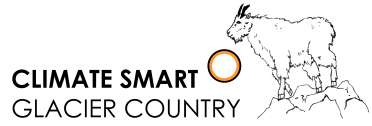As warming oceans and hotter air unleash heavier rains and angrier storms, communities across North America are being swept by more frequent megafloods. Could this happen in the Flathead Valley?
That’s the question posed by Climate Smart Glacier Country and more than a dozen public and private partners. In Fall 2025, this partnership will launch a flood scenario project to improve flood preparedness while cutting the escalating cost of flood insurance for residents and businesses in Flathead County.
CSGC initiated this project after witnessing the 2022 Yellowstone floods devastate homes, roads and communities. A firehose of a Pacific storm uncorked torrents in the headwaters of the Yellowstone River, shocking thousands of traumatized people directly affected and upending visits by many more who planned to visit the world’s oldest national park that summer.
The Flathead is not a stranger to megafloods. The valley has experienced four floods since the 1890s — 1894, 1928, 1948 and, most dramatically, 1964 — that flood experts have pegged as 100-year floods or larger. While this statistical recurrence interval has been exceeded over the past 100 years, climate experts
In June 1964, roiling waters roared through the canyon and into the Flathead valley, hurtling houses and cattle, trees, bridges and boulders toward Flathead Lake, which backed up nearly to Columbia Falls, a backward-flowing river miles wide. On the east side of the Continental Divide, at least 31 people died, primarily Blackfeet tribal members, when the Swift and Two Medicine dams collapsed under the onslaught of torrential rains upon a lingering mountain snowpack.
The scale of the 1964 flood is considered to have a recurrence interval between 500 and 1000 years. In reality, the so-called flood return interval is a statistical estimated. So-called 100-year floods have historically heppened more frequently in the Flathead. And looking ahead, climate scientists confirm what most Americans are observing with their own eyes. Globally, massive floods are happening more often. Locally, the Montana Climate Assessment projects an increasing number of days, especially in winter and spring, with heavy rainfall. What might have been considered a 100-year flood a few decades ago will likely happen more often in the coming decades.
But whatever its statistical validity, the 100-year benchmark remains highly relevant to daily lives. That’s because floodplain regulations adopted by local governments under the direction of the Federal Emergency Management Agency (FEMA) revolve around the 1% chance of a large flood in any given year. Mortgage lenders will require flood insurance if you buy a house within that floodplain.
The Western Montana Hazard Mitigation Plan, adopted in Spring 2025 by the county and cities of the Flathead, shows that 10% of Flathead residents, or 11,481 people, live within the 100-year floodplain. A flood of that magnitude would cause $383 million in damages and damage 136 critical facilities that provide essential energy, transportation and health services.
And what would be the impact of a 1964-scale deluge today? No one knows. That’s why this project seeks to map the impact zone and evaluate who and what would be affected.
Unfortunately, that assessment may remain elusive. While CSGC has received some funding support from the Whitefish Community Foundation and the interagency Western Montana Conservation Commission, we are seeking new sources to replace a $75,000 federal grant to CSGC that was terminated by the Trump Administration. No specific reason was given for the termination of EPA’s Thriving Communities program, although President Trump has indicated that disaster planning and climate resilience are not priorities.
While we hope to complete some level of impact assessment and engage local communities to develop flood mitigation strategies, our scaled-back project is slated to focus more narrowly on increasing pubnlic awareness about the shifting risks. A particular goal is to expand Flathead County’s participation in FEMA’s Community Rating System, which incentivizes local governments to go beyond the bare minimum requirements for floodplain management by reducing flood insurance premiums for residents and businesses.

Flathead County is one of 10 Montana communities that participate in CRS, although currently at the lowest level providing for a 5% discount. Other Montana communities receive discounts of 15-20%. We also seek to enroll the cities of Kalispell, Columbia Falls and Whitefish in the CRS program, thus improving housing affordability to taking a bite out of insurance costs.
Over the next 18 months, we will be working with our partners to organize flood awareness events, identify flood mitigation strategies to minimize future damages, and improve flood-related mapping. Stay tuned!


